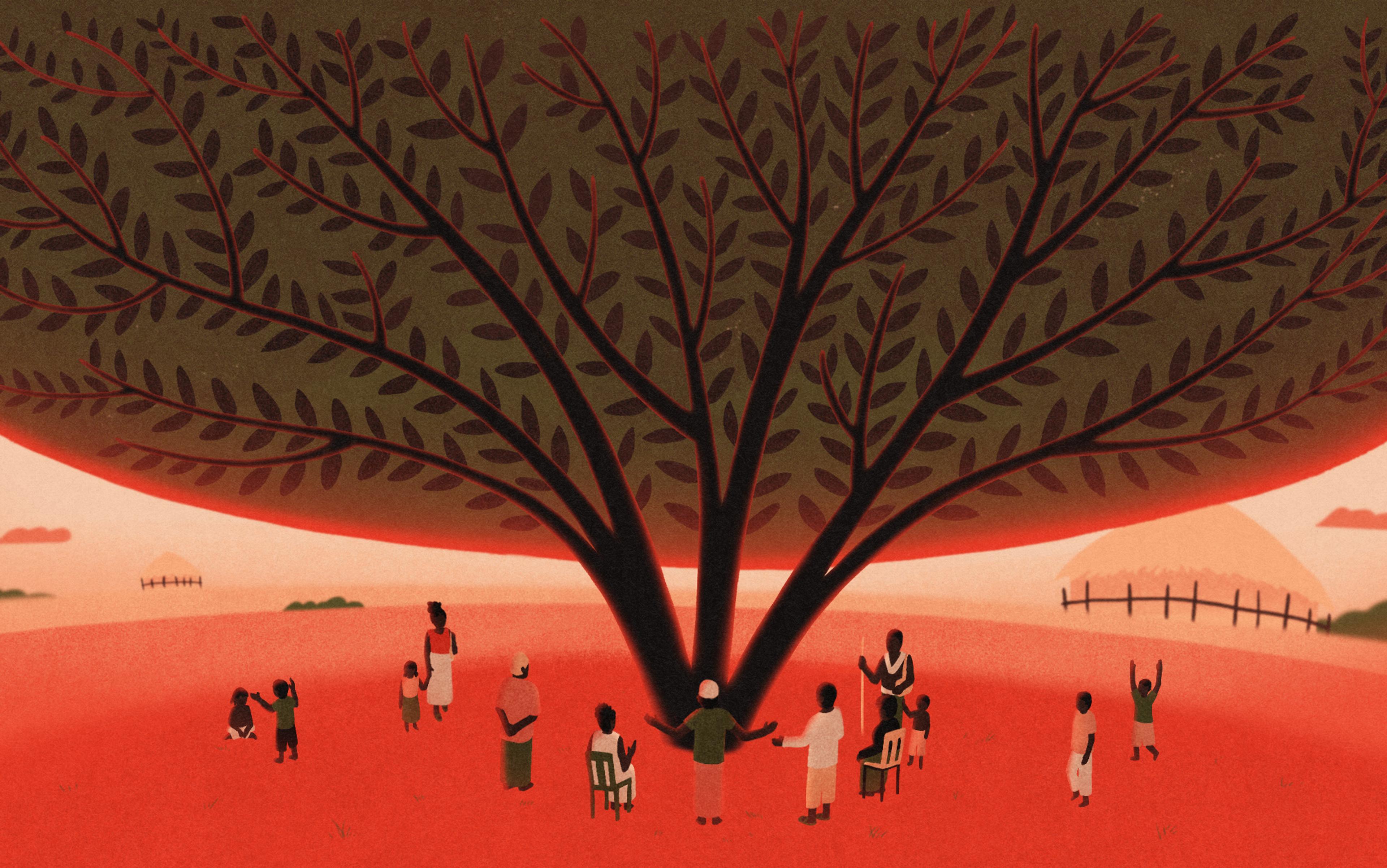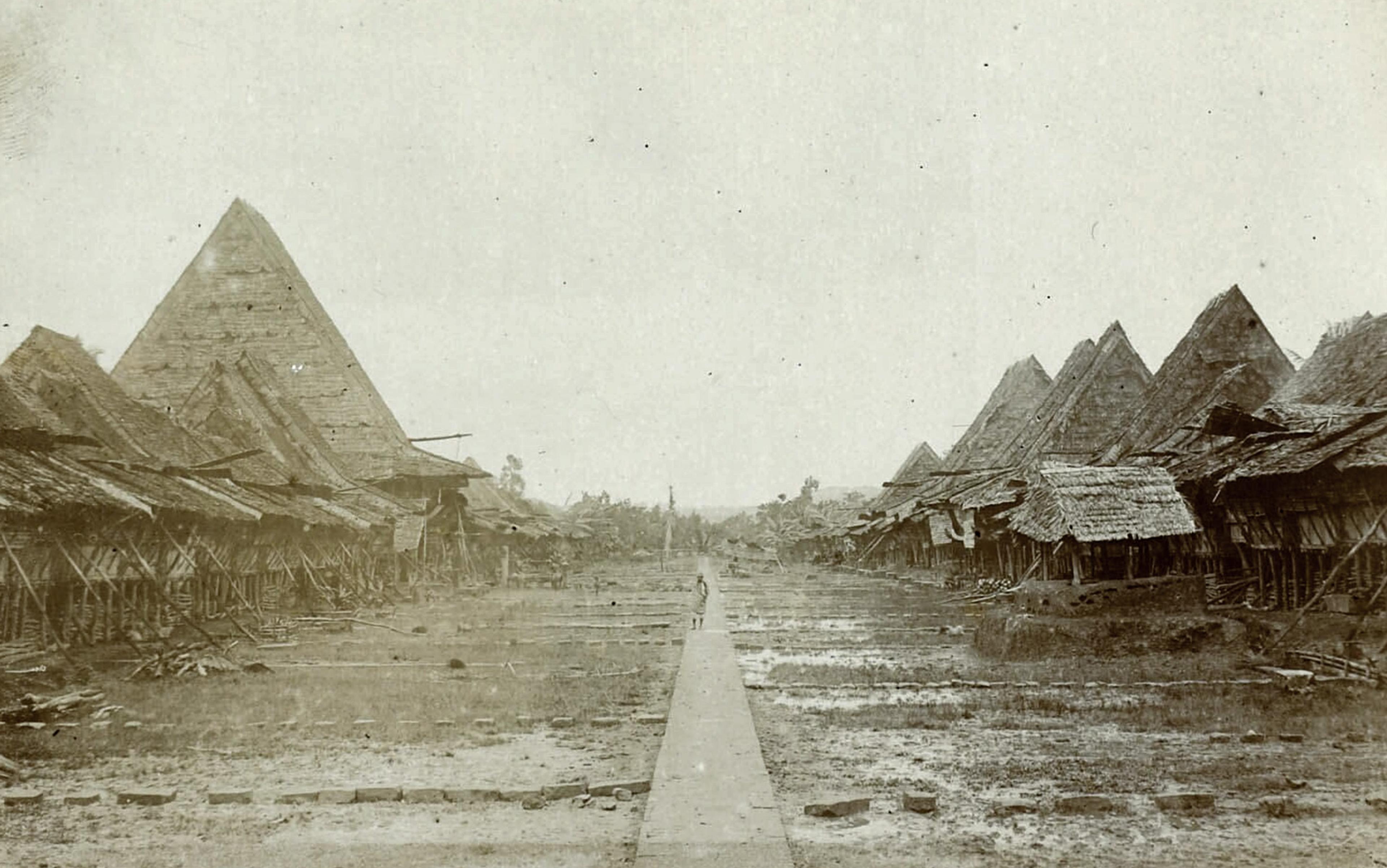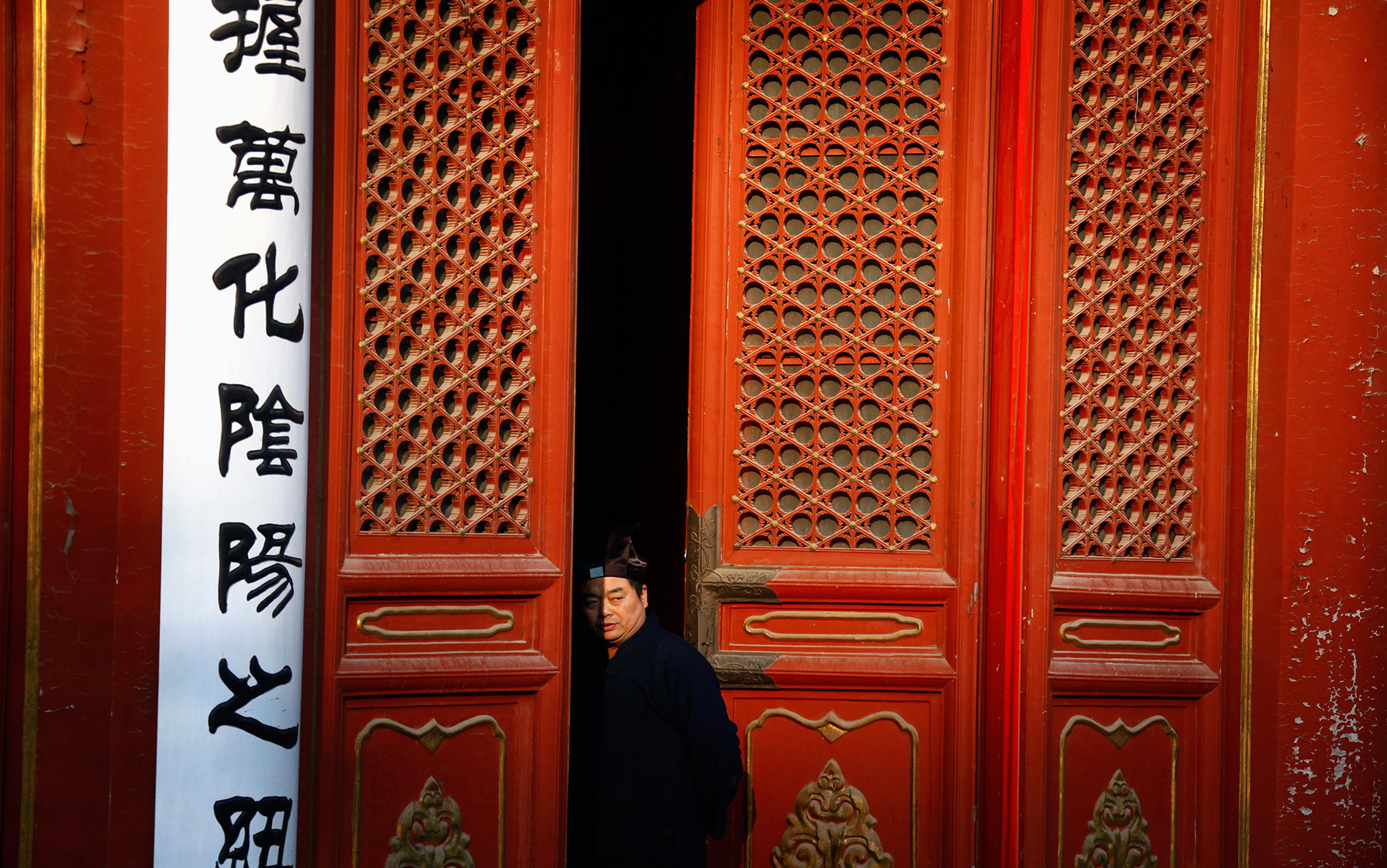Blood from a chicken’s crest was sprinkled over a fire, and its bleeding head was touched against hot stones and a cooking pot. The chicken was then held over the flames and its feathers burnt off before it was cooked with a set of 19 leaves and other ingredients (which must remain secret). Then, as I looked to the east, palm wine mixed with potions was poured into my eyes to ‘open’ them so I could see clearly. And, finally, a portion of the prepared meal was put to one side and later dropped into the hole of a spider (or crab) to ensure that it would continue to tell the truth. This is how, in a Cameroonian village, I was initiated as a spider diviner by the late Wajiri Bi in 1986.
I had travelled to Cameroon as a young anthropologist hoping to study traditional religion and how it connected to local power structures. My research led me to Somié, the smallest of three Mambila villages on the Tikar Plain near the southern border of Nigeria. Somié was settled by the Mambila people, who live between Nigeria and Cameroon in the zone sometimes called the ‘middle belt’: where north meets south in both cultural and ecological terms. A settlement of single-storey homes among verdant farmlands, the village lies at the end of the motorable road. In it are the Chief’s Palace, the state dispensary, several churches, mosques, schools and, built this century, a solar power installation. Today the village has more than 5,000 residents, but when I arrived in the mid-1980s, the population was recorded as 1,006. A lot has changed since then, but some things have remained the same, particularly governance. The region was never fully incorporated into any larger state until the imposition of colonial rule after the First World War, and it remains at a distance from state power. This was what initially interested me: how were complex disputes settled in Somié without state involvement? What role did religion play?
My research interests led me to the village chief’s court, where I followed dispute resolution processes and the ritual oath-taking many solutions depend upon. As I learned the local language, Jù Bà (a Mambila dialect), and began to understand the interactions in court, I started to pay closer attention to the role of diviners, who were sometimes consulted to decide the answers to questions arising from a case. Had this man committed adultery despite his denials? Had a loan been repaid in full?
Wajiri Bi was often involved in such cases. He was the headman of an outlying hamlet (hence his honorific title ‘Wajiri’) and one of two chiefmakers in the village. People consulted Bi not only from Somié, where he lived and worked, but from other areas, too. Like most diviners, he knew several forms of divination. However, only one method was trusted for serious cases: spiders.
The methods behind spider divination and the principles of interpretation are widely known in Somié, and many people had told me about them. But knowing the ideas is different from being able to put them into practice. For that, I needed to be initiated. I asked Bi if he would teach me, and he did so willingly. There’s a delicacy here: some things I can describe only in outline to preserve the initiatory secrets. (Thankfully, the secrets associated with initiation do not apply to the things that I have shared here or elsewhere.) Without giving anything away, the ritual involved us simply preparing meals together and feeding portions of those meals to spiders to keep them as truth-tellers. No theoretical justification was provided for initiation, nor was any forthcoming, despite my many questions.
Since 1985, I have returned to Somié almost every year, continuing to learn from Bi and other diviners. That means I have been studying Mambila divination on and off for 40 years. In that time, through the guidance of my teachers, I have come to recognise that what first appeared as a local, esoteric practice reveals a broader, even universal, logic: a practical and sophisticated system for making decisions and managing uncertainty in contexts where definitive knowledge is elusive. Each time I return to the Somié, I find new connections extending outward, linking the particularities of divinatory practice in the village to wider questions of truth, interpretation and decision-making.
The question ‘What should I do?’ is a universal and ancient problem that has remained almost unchanged throughout human history. We can’t know the future in the same way we know the present (and some of the past), which means all people share similar concerns: who should I marry? Why am I ill? How should my sick child be treated? Should I move for a better life? Concerns about the future are not only important to individuals. They also matter to states: should we go to war? Should we raise or cut taxes?
The point of this randomness is that the diviner cannot influence the result
All of these are seemingly unanswerable at the immediate point of asking. The future appears unknowable. Enter the diviner, with skills and access to answers that others do not have. Though explanations of their uncanny skills vary enormously, the questions that are asked of them are similar around the world. For this reason, divination appears everywhere and is a contender for the ‘oldest profession’ (alongside warrior, prostitute and priest). It is truly universal.
We might be familiar with quotidian forms of divination, such as tarot cards, but divinatory practices differ hugely from one another and so do the accounts given by different practitioners to explain how and why their method functions. This makes providing general definitions of divination difficult and contentious. For example, is astrology a form of divination? It is for some, but not for others.
In many forms of divination, randomness is important. Examples include bibliomancy (opening a holy text and picking a verse at random), tarot and other sorts of cartomancy (shuffling the cards and picking some at random), Yijing and Ifá (throwing coins or chains; picking up odd or even numbers of sticks or nuts), or African basket divination in which objects placed in a basket are repeatedly tossed in the air (those that settle on top are then interpreted to answer a question). The point of this randomness is that the diviner cannot influence the result, so the message from beyond can be heard without the risk of human manipulation and interference.
But I didn’t study tarot cards, astrology or Ifá. I learned to read the messages left by spiders. So, how do Mambila diviners in Somié generate meaning from ambiguous signs? How do they help people think through uncertainty, negotiate meaning and make decisions? And what might we learn if we took such practices seriously, not as curiosities, but as alternative systems of knowledge in their own right? In a world increasingly marked by uncertainty, divinatory practices can teach us how to decide, act and move forward.
Before discussing the divinatory techniques used in Somié, it is worth noting the uses to which they are put. By far the two largest categories of questions asked, together accounting for almost half of all cases, concern illness (or health more generally) and family (such as issues related to marriage).
Illness prompts questions about what treatments are appropriate, and where they should be sought. Such questions can implicitly explore whether the illness has been caused by witchcraft or whether it has occurred naturally, which Mambila idiom describes as ‘coming from God’. Family problems also create dilemmas about unknowable futures: ‘My sister is considering marrying someone. Will it go well?’ Suspicions of adultery in established marriages might also be tested through divination. Aside from illness and family, other types of questions are asked about theft, lost livestock, or whether the time is propitious for building a new house (or investing in a motorcycle).
There are many types of Mambila divination. Some are dismissed as frivolous but others are taken more seriously. Two types of divination have become widely used in Somié. The first is spider divination, known as ŋgam dù (literally ‘divination [of the] ground’). The second is ŋgam tubu (‘divination [of the] tubu-vine’).
The more serious the matter becomes, the more authoritative the form of divination eventually consulted
Another form, sand divination, became briefly popular in recent years but is not trusted enough to be used in court cases. In this form of divination, sand is placed in a circular tray and smoothed flat. With a finger, a diviner draws and redraws a series of dots and dashes into the surface, until they are satisfied with the result. He then interprets the final pattern to give an answer. Figure 1 below shows the final result of a consultation. Since the height of its popularity around 2015, interest in sand divination has waned: by 2019, it was hard to find any practitioners in the village centre. Other types of divination used in the village either have few operators or are taken less seriously: spider diviners disparagingly describe them as ‘games’. The rubbing hands divination that Bi used (as shown in Figure 2 below) is no longer practised by anyone in the village.

Figure 1: Sand divination

Figure 2: Rubbing hands divination
People often use one form of divination after another: the more serious the matter becomes, the more authoritative the form of divination eventually consulted. For example, an important issue might initially be taken to ŋgam tubu (tubu-vine divination), in which small pieces of a vine are whittled from a section of the creeper. A diviner makes interpretations based on where the pieces fall relative to two sections of the vine that are placed on the ground. Each fallen piece is associated with alternative answers. If the issue is still unresolved, it might then be taken to ŋgam dù (spider divination) for confirmation.

Figure 3: The shy diviner Hysterocrates robustus
Ŋgam dù addresses difficult questions to spiders or land crabs that live in holes in the ground. Two species are used. The spider is Hysterocrates robustus, a large West African tarantula that burrows underground and feeds on insects and small invertebrates. The land crab is Sudanonautes (convexonautes) aubryi, a freshwater crustacean that lives in rivers and rainforests and is also known for its burrowing behaviour. The same techniques are used with both creatures (their habits and habitats being similar). Although I refer here only to spiders, my account applies to both species (all subsequent mentions of ‘spiders’ should be understood to also refer to crabs).
A spider emerges from its burrow, moves the leaf cards relative to the stick and stone, and an answer emerges
Questioning a spider involves first clearing the area around its burrow. Then a large, open pot that has had its base removed is placed over the hole, with a piece of tin used as a lid. The pot and tin keep the spider in a contained space. A stick and stone are left inside, with special marked leaves (which I think of as ‘cards’) placed over the hole. The diviner then asks a question in a yes/no (or either/or) format – with each response corresponding to either the stick or stone – while tapping the enclosure to encourage the spider to emerge from their hole. The stick and stone represent possible answers, while the leaf cards offer the possibility of further clarification.
The ‘leaf cards’ are obtained from shrub species in the Dacryodes genus. Once picked, the leaves are doubled over, pressed flat, and then stored over a fire. A template is used to cut the outline shape that is common to all the cards, similar to that described by the missionary Paul Gebauer, based on fieldwork with a neighbouring group to the Mambila in the 1930s. Ideograms, called ŋgə̀ə (meaning ‘symbol’) are then incised with a razor blade. Figure 4 below shows a photograph of cards being made. Each ideogram is cut into two cards. On the ‘negative’ card, the symbol appears only on the left of the leaf’s central rib. On the ‘positive’ card, it is duplicated on both sides of the rib. A card with one palm tree symbol, for example, refers to a problem associated with palms (such as the danger of falling while harvesting palm-nuts from a tall tree), while a card with two palm tree symbols means that something positive is to be expected from palm trees, such as a good harvest (Figure 5).

Figure 4: Leaf cards being made

Figure 5: Examples of the leaf cards
When a spider emerges from its burrow, it moves the leaf cards relative to the stick and stone, and an answer emerges. Because the leaf cards are roughly arrow-shaped, they can be seen as ‘pointing’ toward the stick or the stone. However, the answer is not always clear. If neither the stick nor the stone are selected (or both are selected), interpretative work is required. The diviner and client must resolve the ambiguity or decide that the spider wasn’t saying anything. This can also be a call to go away, think about the issue and return with a different question.
So, what might it mean if the spider places a card on the stone, but the card’s tip is pointing at the stick? This is what happened when the diviner Bollo Pierre sought a prediction of the US election in 2019, between Donald Trump and Joe Biden. The spider was asked: ‘If the Americans would choose the old president [ie, Trump], then choose the stick, or if they would choose a new one [ie, Biden] then choose the stone.’ The spider put a card on the stone, but the card was pointing at the stick. Bollo the diviner concluded that this meant the US people would choose a new president, but that it would not be straightforward!
There are four basic results in any spider divination. Each card can be placed on the stick or on the stone, or they can be ‘looking’ or ‘pointing’, so that a card might be on the stone but looking at the stick, or vice versa (Figure 6). These possible results can be doubled by further distinguishing whether the cards are flipped over (cards are usually laid over the spider’s hole rib-side up). I was told that an inverted card was ‘bad’, possibly warning of unforeseen problems.

Figure 6: Leaf cards pointing to the stone or the stick
Other results can suggest misfortune. A card balanced on its base against the pot wall augurs well, whereas one balanced on its tip portends death because it is ‘looking’ into the ground (Figure 7). A card pulled down into the hole, or a card pushed out of the enclosure under the rim of the pot, also portends death. One diviner I worked with, Bəbə, distinguished between the different ways a card can be pulled into the spider’s hole. A card that was still flat signified a ‘bad’ situation requiring correction, whereas a card that was folded over signified a death to come. (Figure 8 shows a folded card near the edge of the pot.)

Figure 7: Card balanced on its tip portends death

Figure 8: A folded card near the edge of the pot
Basic principles are sufficient to interpret simple cases, but the real interpretative skill in divination is the ability to explain equivocal results, such as when one card is on the stick and another on the stone – an outcome that suggests both ‘yes’ and ‘no’. As I said, such results are usually rejected as saying nothing, or taken as an indication that the question asked was badly put and needs to be reframed.
If the leaf had been pulled below ground level, that would have been a sign of a death
Experience teaches diviners to pay attention to and interpret these subtleties. In this way, each diviner develops his own idiosyncratic style of interpretation, although always within the scope of the basic rules.
Figure 7 above shows an image from a complex divination session on 1 August 2018. A leaf with six incisions had ‘almost’, in the words of the diviner, been pulled down into the hole. If it had been pulled below ground level completely, that would have been an unambiguous sign of a death. In this configuration, its meaning was unclear. It was interpreted as a sign of something bad but, since it was ‘behind’ the hole, it was auguring something in the distant future, and perhaps not a death but an illness. However, it was unclear whether the distance referred to time or social connection: the illness of a stranger, perhaps? Such equivocal results and their description reveal the limits of abstract accounts.
In practice, each divinatory result is read in the light of preceding ones and may later be reinterpreted if other results suggest different interpretations. No single result can be regarded as final until the end of the session when all the patterns have been considered. The diviner then summarises: this was the question and this was the response. For example, here are some summaries I was provided with:
26 November 2012
Question: A client came to consult about his son who had had an accident with his motorcycle. Did someone provoke this or did it just happen?
Response: It just happened. No one did anything. You must tell him not to drive so fast.
22 August 2015
Question: His daughter has left (a week ago). Will she return?
Response: Yes.
27 August 2015
Question: Ask about his son’s fiancée. Will the marriage work?
Response: Yes. It will go very well.
This is the form of summary that is reported to non-attending clients, including those asking questions by telephone, women (who are traditionally not allowed to attend divination sessions), and anthropologists who ask for results to be written down in their absence.
Was a result merely ‘bad’ or did it mean that ‘a corpse would come’?
Figure 9 below shows a result of a divination undertaken on 1 September 2018. The spider had piled mud from the hole on top of a leaf, metaphorically ‘burying’ it. This was taken as a sign that someone would be buried.

Figure 9: Divination showing that someone would be buried
Other results are taken to indicate ‘traps’, which are problems generally less final than a death. This is indicated when two cards are left propping each other up, so that if one moves the other will fall, thus resembling a deadfall trap.
Though there are standard rules, I began to wonder how different possible interpretations could be. What happens when diviners disagree? To help me understand, a young diviner named Suop provided me with photographs of 335 divination results from 2017 to 2018. I went through 167 of these with him and then separately with another diviner, Bollo Pierre. We then jointly discussed 46 results for which their interpretations differed in ways that I regarded as substantial. In the end, they persuaded me that most of these were differences only of degree: was a result merely ‘bad’ or did it mean that ‘a corpse would come’? Our conversation, anchored by the images of the individual results, ended in broad agreement. I had been too cautious in finding disagreement where they saw none. Such differences are inevitable when talking in the abstract, even when looking at images of actual results. In concrete cases, the range of possible interpretations gives the diviner flexibility to respond, not only to the patterns of the cards, but also to the issue being posed and the ongoing conversation with the client. They do all of this while remaining ‘accountably’ (as conversation analysis would have it) within the rules.
Such accountability is how diviners ensure their interpretations are aligned. But equally important is the alignment (or, rather, calibration) of the spiders themselves. My first teacher, Wajiri Bi, made an explicit parallel between the microscope in the village dispensary and the spiders he worked with. As he explained, both tools needed to be regularly maintained and tested to ensure they are accurate. Other Mambila diviners have offered similar explanations. To make such a calibration, a spider diviner will ask the spider one of two questions: ‘Am I here alone?’ or ‘Will I eat fufu [maize porridge] today?’, to check that it is telling the truth. If a spider fails these tests, it is discarded as being unreliable and unfit for divination.
Even when a diviner is skilled and a spider is well calibrated, it may be better not to seek answers using ŋgam dù. Each time I visit the village, I am gently reminded that there are some things it is best not to ask. Part of my research consists of trying to understand such questions. Weather forecasts are a case in point.
The rain in Somié is regular and plentiful. During the rainy season, black clouds can form over the eastern side of Mayo Darlé (Mount Guengué) then slowly slide down to the plain, and a wall of rain sweeps over the village. Occasionally, rain comes from the northwest, across the Mambilla Plateau ‘behind’ the village.
However, in both cases, a rainstorm can change path slightly at the last minute and bypass the village. This means that, even when you can see a wall of rain seemingly coming straight towards Somié – as happened just yesterday and the day before – you cannot be sure that it will rain in the village. And so, I have learnt not to ask the spiders if it is going to rain.
Mambila people are wary of drawing conclusions based on patterns observed in the past. Their corner of the world does not encourage it. Just because something happened in the past doesn’t mean it will happen again. The diviners I learned from have been cautious of this kind of ‘inductive reasoning’ in the classic philosophical sense – a form of reasoning that thinkers such as David Hume and Bertrand Russell also saw as a problem.
When divining about an illness, you should not ask ‘Will this person die?’
Even at the height of the rainy season, when storms are so plentiful that it can rain all day, I have never heard a diviner ask whether it will rain today (or tomorrow). Nor have I heard such questions asked seriously by someone who was depending on good weather for an upcoming marriage feast, for example. There are some things that even spiders cannot predict.
The most common question that is never asked is the following: ‘Will my problem be solved?’ A negative answer would deny hope. There is always hope, so the question is not asked.
A senior diviner (in consultation with another diviner) discussed this idea with me. He was clear that when divining about an illness, you should not ask ‘Will this person die?’ For my diviner friend, ‘divination does not lie’, so if the leaf cards say ‘someone will die’, then they will die. Retrospectively ascribing events with inevitability in this way is known by some scholars as ‘creeping determinism’. But my friend is not a hard-nosed determinist (except when discussion with an anthropologist makes him so). He explained that if you do not ask the question, then the possibility of recovery remains. For him, the divinatory process seems to fix the outcome. Asking a question and receiving an answer rules out options that would have been left open if the question had never been asked. In his example of a question about an illness, recovery remained an option as long as it was not ruled out by asking about it. So, the options put to divination sketch the bounds of possibility for diviners and their clients. They form the backdrop to the consultation, its ‘horizon of expectation’.
This aspect of question-framing suggests a Mambila version of Schrödinger’s cat, in which the cat sits in a limbo of superposed possibilities, being both dead and alive, until the act of inspection, in the language of physicists, ‘collapses the wave function’, bringing about one state or the other. In the Mambila version, the superposed state would end, not when the box was opened, but when the possibility of death was asked and then answered by spider divination. In such a case, a Mambila diviner might say that the spider had opened the box behind the scenes and reported what it found.
The notion that divination affects outcomes has interesting and perplexing implications. It allows Mambila clients some say in how far their future is fixed. By not divining, or by divining but choosing their questions (to leave positive outcomes in play), they keep the future more open. My teachers in Somié have shown me that we make our futures not only by the choices we make but, before then, by the outcomes we contemplate and the patterns of our multiple anticipations.
Variant forms of spider divination are widespread in southern Cameroon. There is nothing special about the Mambila in this respect. One way of appreciating this is that the general word for divination – ŋgam – is an old word indeed. There are variant forms of the term in many of the local languages and divinatory techniques across southern Cameroon. This is similar to the way that there are connected forms of astrology that extend far beyond Europe, which also reflect some ancient Babylonian ideas.
Today in Somié, most adult men, and many women, know at least the basic principles of interpretation, even if they have not been formally taught how to divine. More men have been taught than regularly practise ŋgam dù. Among those who practise, some are widely regarded as experts and attract clients from far afield. Senior diviners are regularly consulted by clients who travel from Nyamboya (32 km away) or Bankim (60 km away) for consultations; since Somié received coverage in magazines and newspapers a few years ago, local diviners now receive enquiries from further away by mobile phone or even via the internet. In Somié’s centre in the mid-1980s, there were five regular practitioners, and in immediately outlying hamlets there were three other highly reputed men (Wajiri Bi among them) whom people from the centre regularly consulted. By the mid-2010s, this number had dropped to three in central Somié. In mid-2025, one of those three was ill, so there were only two regularly practising.
The political role of divination, and particularly of ŋgam dù, remains ambiguous. Though it is commonly regarded as an essential skill, expected of all senior men, this has not been formalised. Knowledge of ŋgam dù is a common means of achieving influence, and so contributes to the exercise of power. However, it is neither necessary nor sufficient for political success.
Inside their burrows, ‘truth-telling’ spiders waited to be asked questions that might untangle the future
It should be stressed that there is a range of different attitudes to divination (of all types) among Mambila people. Some use it frequently, others never. Some of those who avoid it have publicly expressed sceptical attitudes, along the lines of ‘I tried it once, it was wrong, never again.’ On the other hand, enthusiasts rave about its successes. Some people consult regularly, others only rarely, perhaps prompted by an illness that proves hard to cure.
Divination results can guide treatment decisions, investment decisions, and decisions about whether a marriage will survive (or even whether it occurs at all). But not all results are slavishly followed. Sometimes, second or third opinions are sought from other diviners. Sometimes, the clients think about things in light of the divinatory results and end up doing something different. Studying Mambila divination can help us understand how the question ‘What should I do?’ is answered in practice.
Each year, I go back to the village to have discussions with the diviners about the cases they have been consulted about. In 2025, I returned to Somié to also celebrate the 40th anniversary of starting my research and to participate in the Sua, a male masquerade that normally takes place each year involving performances and initiations. But when I arrived, I found that large-scale ritual events had been paused due to ongoing disputes between the chief, his advisors and those in charge of rituals. What had happened? Who was right? Who had been wronged? The issue was debated throughout the village. It was the exact kind of complex dispute I had come here to understand in the mid-1980s. And, like many of those disputes, it appeared irresolvable.
What should be done? Had the time yet come to ask for help? Across the village, kept well-fed inside their burrows, ‘truth-telling’ spiders were waiting to be asked questions that might untangle the future.
Life on earth is messy. We argue with those around us about what should be done. Governance is contested. Politics, at a local and international level, is overrun with problems. But sometimes, despite what appear to be irresolvable differences, people must still make decisions about what to do. Perhaps this is why there have always been, and always will be, diviners.






